In this review, we take a look at the groundbreaking Tamron 35-150mm f/2-2.8 Di III VXD for Sony FE-mount.
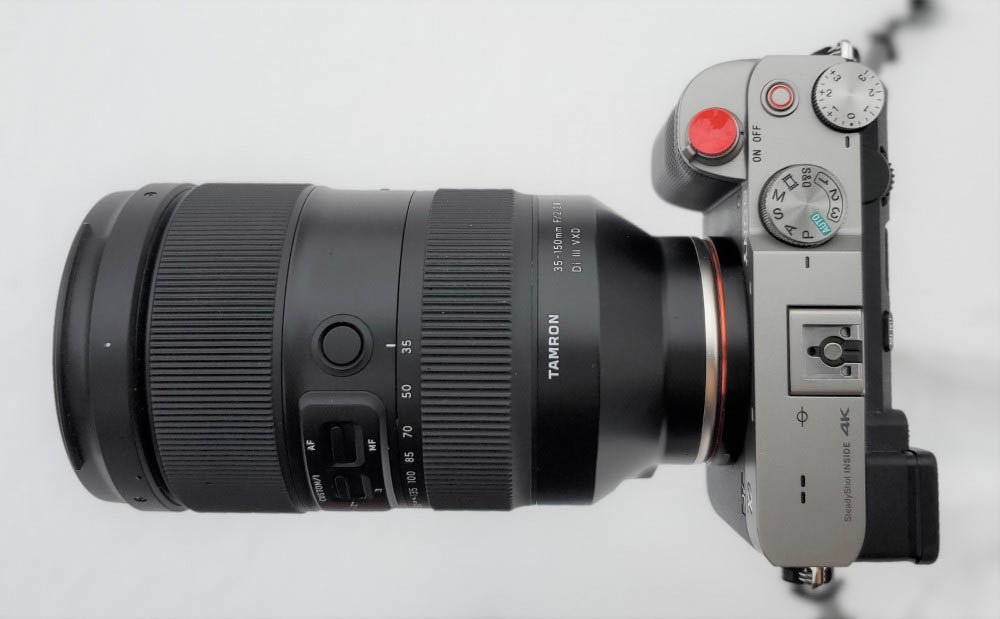
Table of Contents[Hide][Show]
Introduction
Regardless of the manufacturer, lenses being proposed to photographers are often quite similar, at least I n the basic characteristics. For this reason, Tamron generated a lot of interest when they released a 35-150mm lens.
This focal range is rare, but what sets this lens apart is the aperture range. Indeed, the lens touches “prime lens” territory with a maximum aperture of F2 at the wide end, and a fast F2.8 over the rest of the range.
With this lens, Tamron continues to flesh out its lens lineup in innovative ways. After proposing simplified (and cheaper) alternatives to the classical trinity of fast zooms, the 35-150mm F2.-F2.8 aims to be a one-stop-shop for high-quality optics, replacing several primes and zooms in a single lens.
The lens has a long list of features: fastest aperture for a FE-mount zoom lens ever, linear AF motor (called VXD and arguably Tamron’s most advanced AF system to date), weather sealing, USB-C port and compatibility with Tamron Lens Utility software, numerous external controls, 9 rounded aperture blades, advanced coatings, and more.
In this in-depth review, we will take a look at all the technical and artistic parameters which help to define a lens. Read on to find out everything there is to know about the Tamron 35-150mm f/2-2.8 Di III VXD!
Specifications
| Lens Name | Tamron 35-150mm f/2-2.8 Di III VXD (Model A058) |
| Optical formula | 21 elements in 15 groups |
| Image circle | Full frame |
| Field of view diagonal | FF: 63.4° – 16.4° APS-C: 43.8° – 10.7° |
| Aperture range | F2/F16 – F2.8/F22 |
| Aperture blades | 9, curved |
| Aperture ring | No |
| Max magnification | 0.18X |
| Minimum focus distance | 0.33m (wide) – 0.85m (tele) |
| Internal focus | Yes |
| Filter thread diameter | 82mm |
| Lens cap | Plastic, clip-on |
| Lens hood | Removable petal-shaped |
| Diameter x Length | 89.2 x 158 mm (3.5 x 6.2 in) |
| Weight | 1165 g (41.1 oz) |
| Price (US MSRP) | $1899 |
Construction and Handling
In this section, we take a look at the physical characteristics of the Tamron 35-150mm.
Front Element
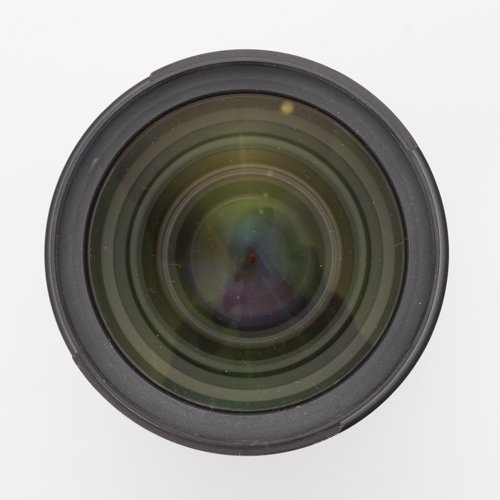
The front of the lens is devoid of markings. The glass takes up a large part of the total front surface. It bears fluorine coatings to repel water and grease.
The lens uses a big 82mm filter thread. This is a departure from other Tamron lenses. Most of the FE lenses use 67mm, from the small primes to larger tele zooms. 82mm filters are necessary here, but they will be more expensive than smaller options, of course.
The lens cap is plastic, and a bit thick, similar to caps for other Tamron lenses.
Lens Body
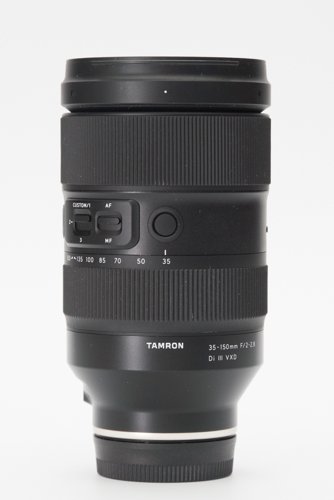
The Tamron 35-150mm has a complex body, especially compared with what the company usually does. There are numerous controls on the lens itself. The body is made of polycarbonate and is sealed against water ingress. The lens is large and somewhat heavy, but not surprising considering the characteristics of the lens.
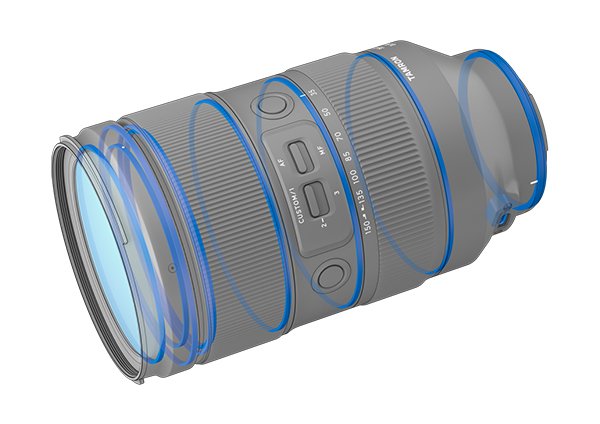
Despite the use of plastic, the 35-150mm doesn’t feel cheap or fragile. It is a substantial lens, finely assembled with tight tolerances. The company’s new finish feels a bit more premium than what was used in the past.
The bottom of the body, near the camera mount, bears a silver ring. This nicely matches the dual-color of the Sony A7C. A discrete mark next to the silver ring helps to line up the lens for mounting. Above, the lens tapers out to a much larger diameter. The main shaft of the lens has a constant diameter; it is essentially a cylinder.

On the taper, the lens bears the USB-C port used to update and customize the lens thanks to the Tamron Lens Utility software.
At the base of the cylindrical section are the brand name and lens name, printed in white. At the back are the certification markings and the “Designed in Japan” label. Higher up is the wide zoom ring. It bears multiple focal length markings. This ring can be locked in place via a switch to prevent zoom creep.
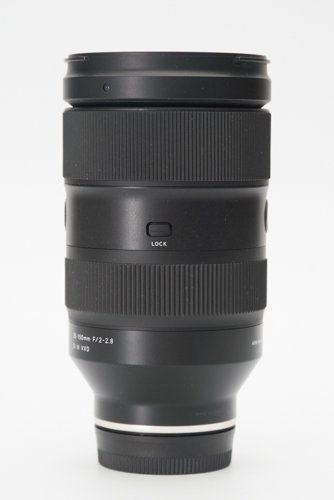
The ring is ribbed and easy to find. Most Tamron lenses place the focus ring close to the camera, and the zoom ring towards the front. Seasoned users will need a few moments to adapt to this change.

Next are the lens’ external controls. One such is a common AF/MF switch. Second are the three Focus Hold buttons, whose function can be set in-camera. Last is a Custom switch, which has three positions, giving access to three stored functions. These functions are set via the company’s software.
Next is the focus ring. As with other E-mount lenses, the 35-150mm uses focus by wire and, while it does offer manual focus override, this must be activated in a menu and cannot be used with continuous AF.
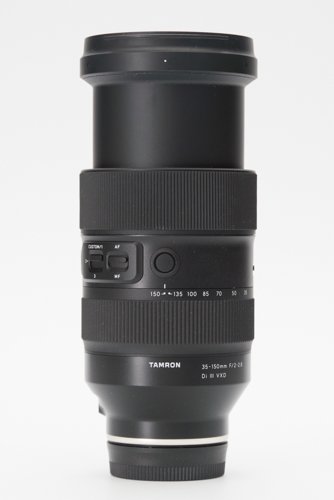
The lens extends significantly when zooming.
Aperture
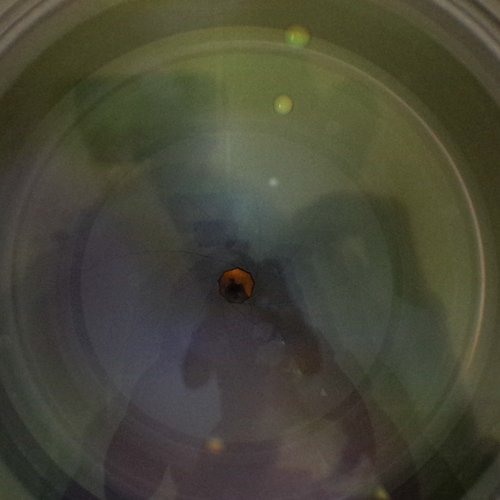
The Tamron 35-150mm uses 9 curved aperture blades.
Lens Mount
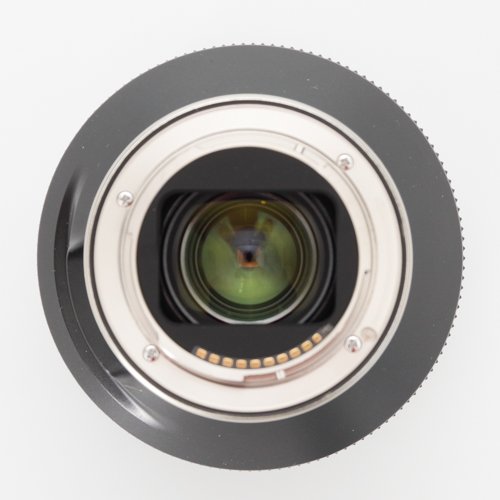
The lens mount is metal, and features a black o-ring to protect against water ingress. There is a rectangular cut-out on the back, to diminish stray reflections. To some extent, it serves a function akin to a lens hood.
Lens hood
The lens ships with a plastic lens hood. It is petal-shaped and, as usual, reverses for storage. It is a bit finnicky to mount reversed. One new feature is the presence of a lock on the hood. To remove it, a button needs to be depressed. This will probably be more robust than the usual, which relies on friction only to hold hoods in place.
Mounted On Camera
The Tamron 35-150mm is a big lens, but still manages to handle well with the small Sony A7C. Holding the lens instead of the camera will still be advisable whenever possible. Tamron did not supply a foot for the lens, considering that the weight is low enough. The lens dwarfs the diminutive camera but still handles comfortably.
Side by side
Here is the Tamron 35-150mm next to the Tamron 70-180mm and Tamron 28-75mm G2 lenses. The 35-150mm is slightly bigger than the 70-80mm, and significantly larger than the 28-75mm.

Focusing
When writing our review of the Tamron 70-180mm, we mentioned that its AF system was the best we’ve seen. The 35-150mm uses the same VXD (Voice-coil eXtreme-torque Driver). The former actually used two motors in conjunction, whereas the later uses only one because only one glass group moves to focus.
In use, the 35-150mm is extremely responsive. Focusing feels fast and is almost completely silent. The lens keeps up with subject tracking using AF-C. It supports every focusing mode available on the A7C.
There is a manual focus switch on the lens, a welcome addition generally missing from Tamron lenses. The focus ring is adequately dampened and shouldn’t move accidentally. It provides passable feedback to the user, adequate but nothing special. The precision of the focus adjustments will be dictated by the speed of rotation of the focus ring. Tamron did a good job even though focus-by-wire is not as direct as mechanical focusing. Thanks to the USB-C port and Tamron’s software, it is possible to tune the responsiveness of the focus ring, its linearity and sensitivity of the ring, and even program focus pulls for videos!
We observed no occurrences of hunting during our tests. However, we did come upon occurrences of back focusing. In the example below, the subject was moving at an angle towards the camera. Most images in the burst were properly in focus, but some ended up with strong back-focus, where the system simply lost the subject despite it being contrasted with regards to the background.

Full size image 
100% crop
AF Speed
AF speed was tested with the A7C. The subject was a black cross on a white background, about 1.5 meters in front of the camera. We used the central focus point. Three measurements were averaged for each data point.
For reference, 5 EV corresponds roughly to a small room lit with a 60 W bulb, and a sunny day corresponds to 16 EV, and a moonlit night to -2 EV.
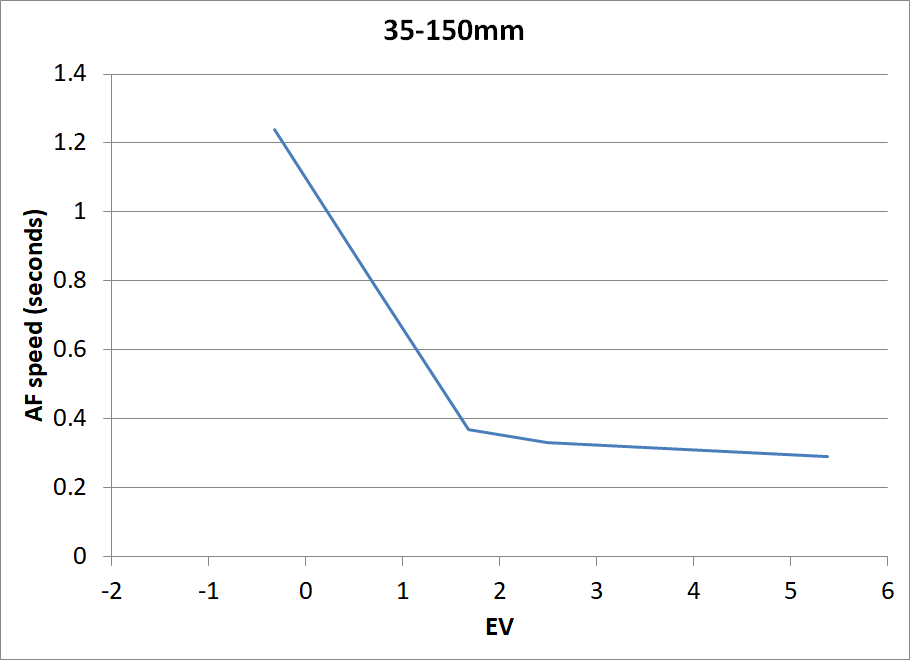
There are two regimes when testing focus with the Tamron 35-150mm. Below 2 EV, the lens can be somewhat slow in very low light, with a linear increase as light increases. At 2 EV and more, measurements become hard to make; focus is essentially instantaneous. AF speed drops to around 0.3 seconds, and becomes almost independent on light levels.
In summary, the Tamron 35-150mm does superbly well in good light, and adequately in low light.
AF Tracking
AF tracking, or continuous AF, is a hallmark of Sony cameras. As such, it is important to evaluate whether or not the Tamron 35-150mm can keep up with fast movements of the subject.
In our experience, the lens generally performs well in this regard. Most of the time, it was able to keep track of subjects with ease.
The following animation shows a series of images, and involves movement diagonal to the photographer, and a rotation of the camera. The 8 images remained well focused. Moreover, the AF was initiated after the subject started moving.

General Image Quality
Before diving into the technical aspects of this review, let’s have a look at the more subjective elements which can make or break an image.
Field of View
The usefulness of this lens is hard to overstate. Thanks to its range and fast aperture, it can effectively replace several other lenses. This makes it a jack-of-all-trades without the compromises normally associated with lenses trying to do too much. It doesn’t offer true wide-angle capabilities, but makes up for it by the sheer versatility of its extended zoom range.

This lens will be an ideal choice for travelers looking for convenience and stellar optical performances. Coupled with Tamron’s well-regarded moisture resistance, the 35-150mm will significantly limit the need to carry multiple lenses and swap them while shooting.

The Tamron 35-150mm will also be welcome for portrait and wedding photographers. They will also enjoy the convenient range and take advantage of the fast maximum aperture to create moody portraits with good subject isolation.

In use, the Tamron 35-150mm’s design choices, and their benefits, are obvious. While still large than average, the lens remains easily manageable. Holding the camera and lens in one hand does not become a burden, even after a few hours. Just like with its 28-75mm, Tamron managed to produce a lens both lighter and more compact than its competitors.
The 35-150mm does very well for portraits, with pleasant skin rendering and good subject isolation.
Color and Contrast
Just like other Tamron lenses, the 35-150mm produces rich colors, well saturated without going overboard.

Starbursts
Starbursts are nothing special. The are present at F11 and F16, but not particularly beautiful. At wider apertures, they are nearly absent. This is not a perk of the Tamron 35-150mm.
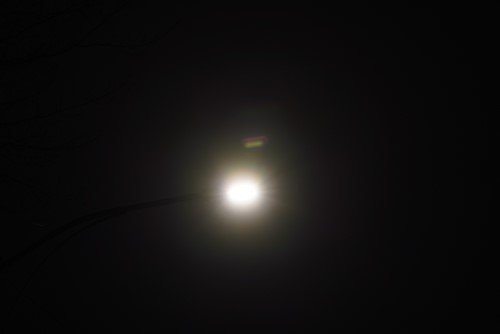

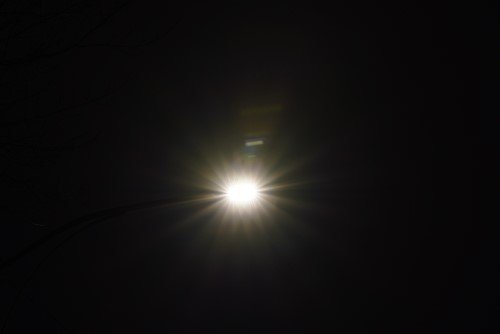
Metering and Exposure
During our tests, exposure was generally consistent and reliable. The lens and camera combo tend to underexpose slightly in difficult situations, like with subjects on snow fields.
Sharpness
Sharpness, or a lens’s ability to resolve small details, is far from the only important characteristic of a lens, but it is probably the one which many users look at first. Soft images distract the viewer and the sharpest point in an image draws the eye.
There are several ways to measure resolution. Some are quantitative, such as the number of lines per millimeter that can be resolved, while others are comparative, such as using a standardized scene to pit lenses against one another. We will use the latter, and supplement it with real-life examples below.
To evaluate sharpness, we use a standard test chart that can be used to compare lenses to one another. We place the camera and lenses at a distance of 100x the focal length, so that the chart occupies the same area on all test images. This results in distances of 7-18 m in the present case. The chart is positioned successively in the center, on the edge and corner off the frame, testing all apertures each time. Focus is repeated for each position to avoid field curvature contributions.
This test will not show how good a lens can be. Quite the contrary, it is a stress test to illustrate the limits of a lens’s capabilities.
Resolution is of course sensor-relevant. For this test we use the A7C camera’s 24 MP sensor.
Test results at 35mm
The following images illustrate the results at all apertures at 35mm.
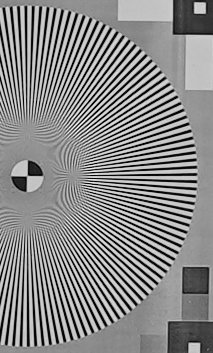
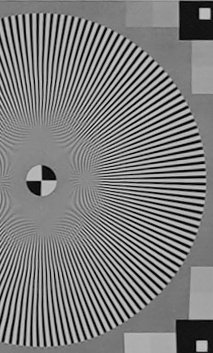
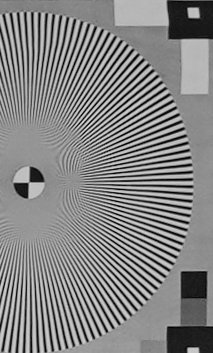
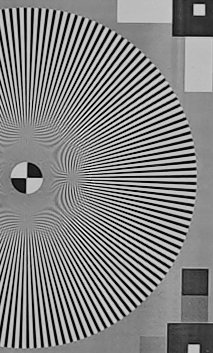
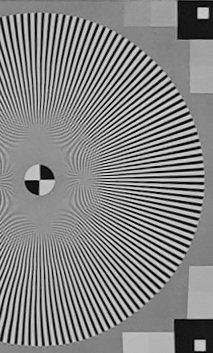
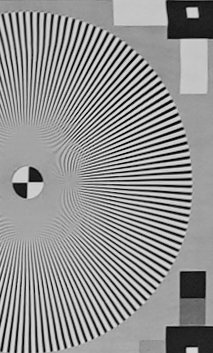

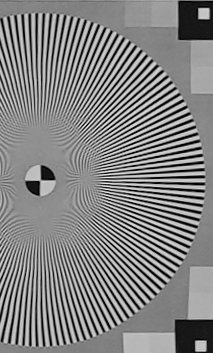
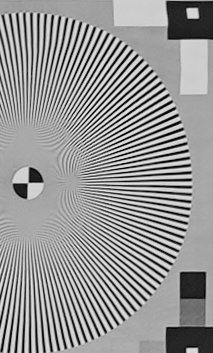

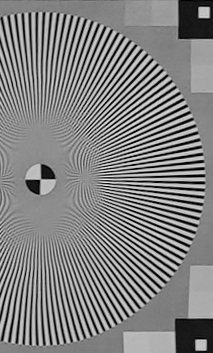

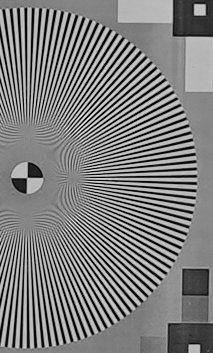



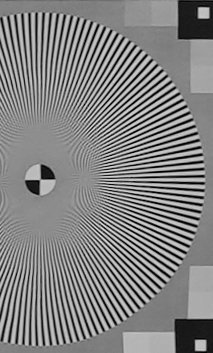

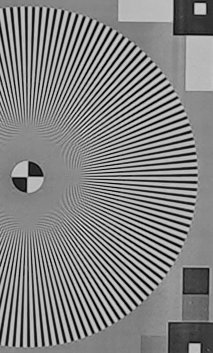

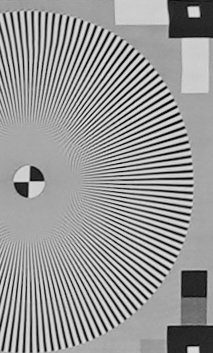
Given its ambitious range and aperture, it wouldn’t be surprising if the Tamron 35-150mm came with worse than average sharpness performances. Thankfully, that’s not the case. Center sharpness is already very good at F2 and 35mm, and reaches excellent results quickly.
Edges and corners are never as good as the center. They reach their peak at F8. Uniformity isn’t high but that’s mainly because the center is so sharp. For scenes requiring edge-to-edge sharpness, F5.6 or F8 is advisable.
Test results at 85mm
The following images illustrate the results at all apertures at 85mm.

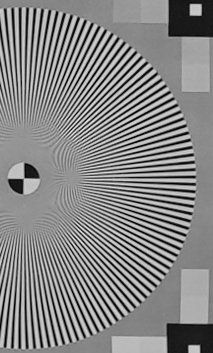
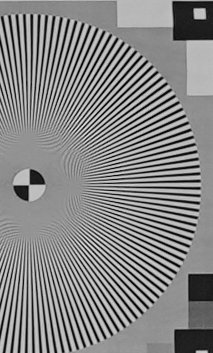


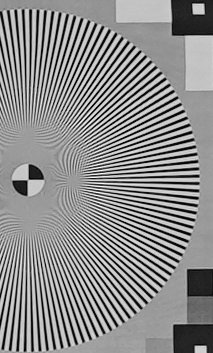


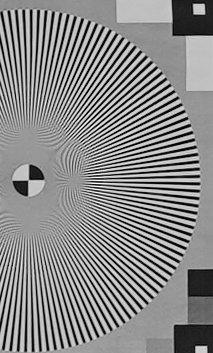

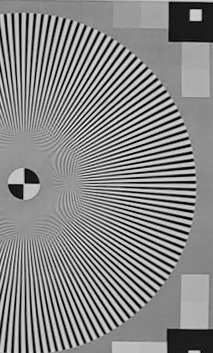



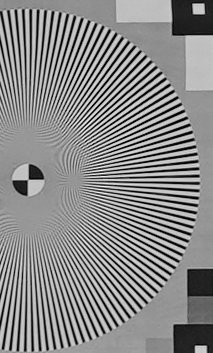
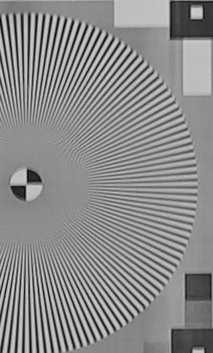

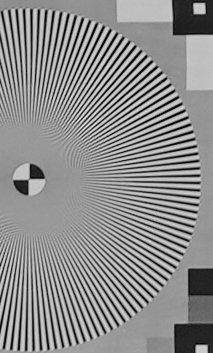
At 85mm and wide open, the Tamron 35-150mm does not produce results as sharp as what we observed at 35mm. On the plus side, uniformity is better. Results are still very good.
Test results at 150mm
The following images illustrate the results at all apertures at 150mm.

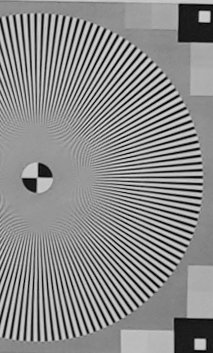
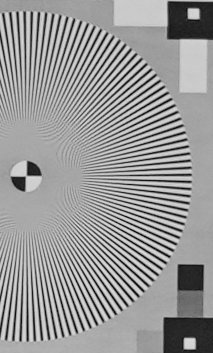
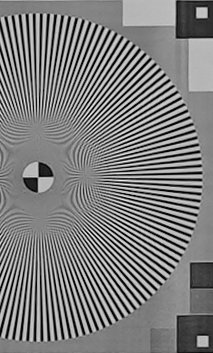



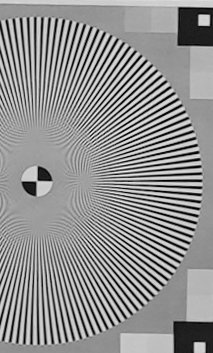



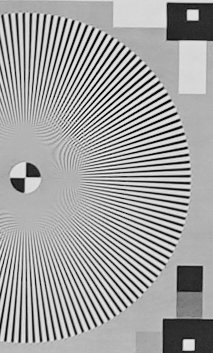

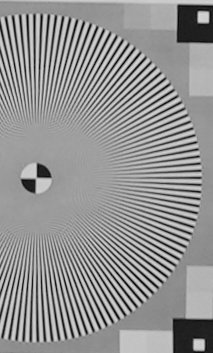


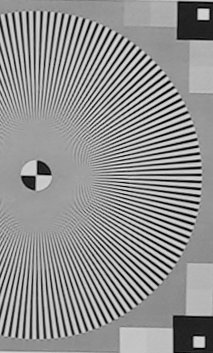
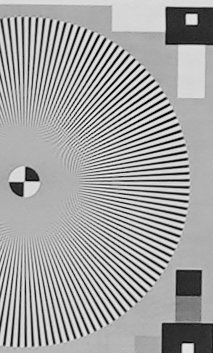


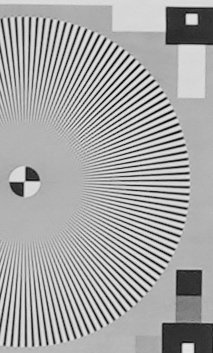
At 150mm, center sharpness is good at F2.8, but quickly improves to excellent at F4 and up to F8. At this focal length, edges and corners never reach the same resolution. Best results are obtained at F5.6 and F8, but the results barely reach very good levels. Softness becomes visible starting at F11.
Summary
In general, the Tamron 35-150mm is a dependable lens in the center at all focal lengths. General performances increase as the aperture widens (or decrease as it lengthens!). This is not a lens for edge-to-edge sharpness, the few compromises done by Tamron touch mainly the sides of the frame.
Vignetting
Vignetting, or the darkening of corners at wider apertures, is both a defect and a feature, as it can be used creatively to put emphasis on subjects closer to the center, create a mood or a vintage look. It can also be corrected automatically by modern cameras so is less of a problem than in the past. That is only true for lenses with electronic contacts, including the Tamron 35-150mm.
The following chart illustrates the vignetting of the lens for full frame when left uncorrected.

Wide open, regardless of the aperture, vignetting is important when left uncorrected. 35mm produces the worst vignetting, something to be expected considering its wider aperture. At F2.8, it compares to other focal lengths. Generally speaking, vignetting is barely dependant on the focal length, with 150mm producing the strongest effect.
The lens must reach F5.6 to see vignetting drop below 1 EV where it is harder to notice. It mostly stabilizes at F8.
We recommend activating automatic vignetting corrections with this lens, unless the effect is used creatively. It is clear that this is one area where the designers made compromises.
The images below show the lens’s vignetting at varying apertures.


















Bokeh
Bokeh is a Japanese term describing the quality of the background blur. It does not relate to the depth of field but to the areas in the image that are beyond the range that is expected to be in focus.
Bokeh is highly subjective. In general, a smooth bokeh with blurred shapes and contours is generally perceived as being of a higher quality. A shallow depth of field does not always equate a more pleasing bokeh.
To evaluate the characteristics of the background blur, we took pictures at varying apertures, using a scene with a lot of detail and bright highlights. The following images show the results.
The Tamron 35-150mm delivers pleasing out-of-focus rendering, particularly around highlights which are nicely rounded and smooth. Even at smaller apertures, textures are nicely blurred and bokeh is pleasing. Transitions are gradual and draw the eye towards the focus point.
The images below are further examples of the lens’ rendering.
Transitions are generally smooth, cat’s eye effect is minimal and highlights do not overcome the scene.
Some Tamron lenses tend to create slightly busy backgrounds, however the 35-150mm does particularly well, as illustrated by the examples below.

Flare and Ghosting
Flare is a decrease in contrast caused by reflections on internal lens elements. Ghosting is the appearance of orb-shaped artifacts in an image containing a light source, caused by the same internal reflections. High-quality coatings reduce the importance of flare and ghosting in an image.
We test flare and ghosting by taking pictures of a bright light source positioned at the center and on an edge of the frame, at varying apertures. We took a look at both extremes of the range.
Test results at 35mm
At 35mm, the Tamron 35-150mm does average for flare and ghosting. In the center, at all apertures there is a halo around the light source, becoming less visible at smaller apertures. Ghosts are also present, becoming more visible starting at F4. On the corner, ghosting is present at all apertures, with the ghosts becoming better defined as the aperture closes. The lens still does better than with the light in the center.
Test results at 85mm
At 85mm, flare is better controlled. It is still present but not nearly as dramatic as at 35mm. Particularly in the center, ghosting is less visible. Some ghosts become more visible starting at F5.6 but they are not as bothersome as at 35mm. With the light in the corner, ghosting is not absent but quite well controlled.
Test results at 150mm
At 150mm, the lens delivers very good results with the light in the center. There is almost no flare at any aperture, and ghosting is minimal. Some flare occurs when the light is in the corner, becoming more bothersome at F8.
Chromatic aberration
Chromatic aberration (CA) occurs because different colours do not always have the same focal point. With modern lenses designs, which are better corrected than vintage designs, this is more likely to occur in out-of-focus areas. CA effects are more visible near fast transitions from bright to dark areas.
Most modern cameras have built-in tools to remove CA. Digital manipulations can have an impact on other aspects of an image, thus it is useful to know how a lens performs when those automatic corrections are disabled.
Our test sets up the camera at 45° and focuses on the center of the frame, with targets at the center, top and bottom. Images are captured at varying apertures at 70mm.


















There is no evidence of CA in the center. At the top and bottom, hints of CA appear at F2.8 and F4. It is gone by F5.6 and not bothersome even when present. Still, we advise activating automatic corrections.
Purple fringing
There were no occurrences of purple fringing in our tests with the Tamron 35-150mm.
Distortion
Distortion refers to a lens’s ability to represent straight lines as straight lines… Wide angle lenses frequently generate barrel distortion, while longer focal lengths are more likely to cause pincushion distortion.
The Tamron 35-150mm covers a roughly 3x focal and reaches a wide aperture. As such, we expect some distortion, particularly at the wider end.
We use a standard test pattern of straight lines and test at varying focal lengths.
The images below show the uncorrected and corrected distortion figures at various focal lengths.
35mm
85mm
150mm
The Tamron 35-150mm shows almost no distortion at 35mm, with only 0.3% of barrel distortion. At 85mm it exhibits stronger pincushion, at 1.3%. 150mm shows similar distortion, at 1.4%.
These results mean that built-in corrections should be used whenever possible.
Sample images
Here is a gallery of samples images captured with the Tamron 35-150mm. You can click on individual images for a larger view.

A7C, 150mm, F4.5, 1/400s, ISO 640 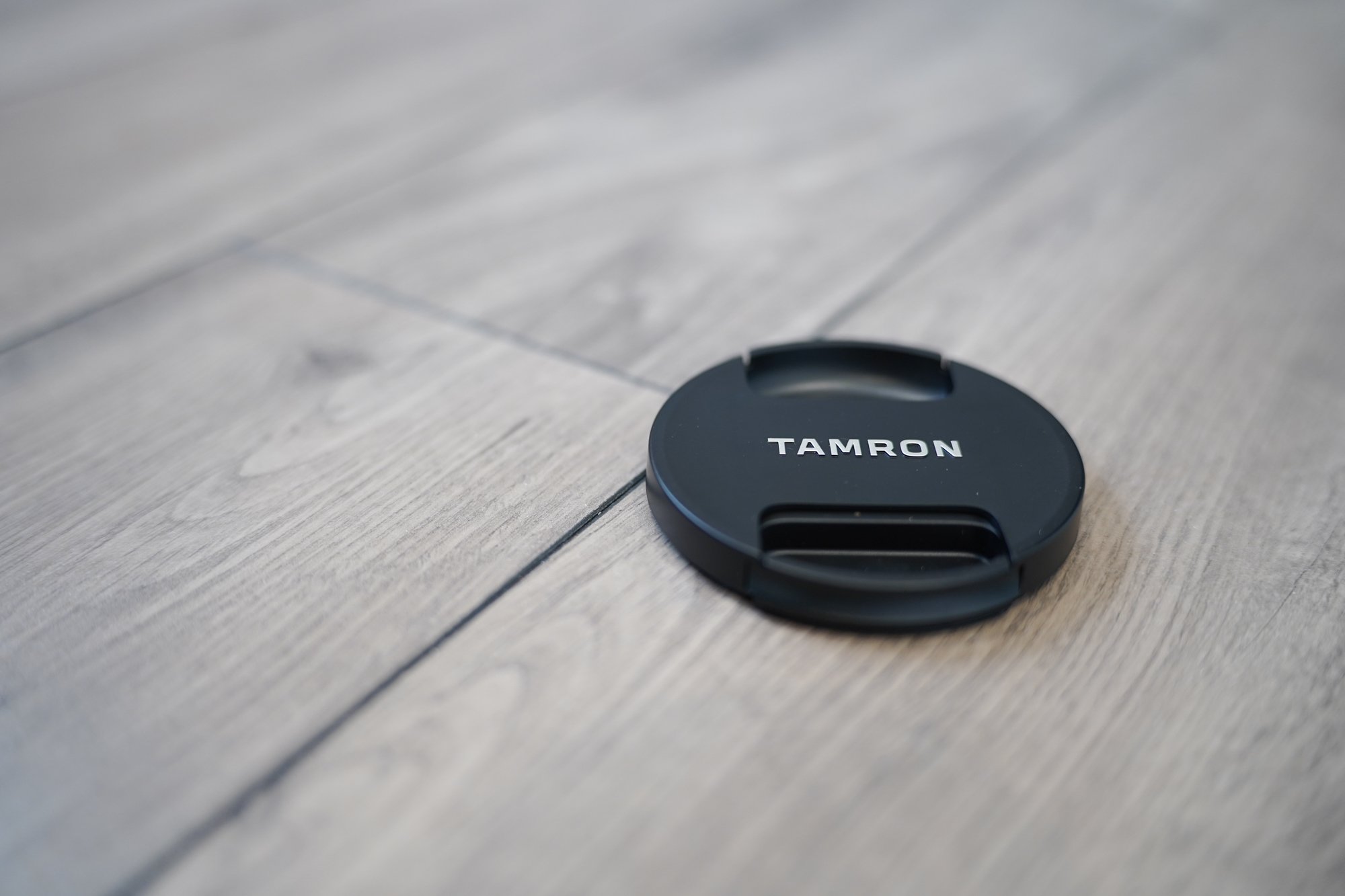
A7C, 35mm, F2, 1/60s, ISO 400 
A7C, 119mm, F2.8, 1/100s, ISO 500 
A7C, 75mm, F4.5, 1/200s, ISO 400 
A7C, 150mm, F4, 1/320s, ISO 400 
A7C, 35mm, F4.5, 1/200s, ISO 400 
A7C, 35mm, F9, 1/60s, ISO 400 
A7C, 81mm, F6.3, 1/320s, ISO 400 
A7C, 36mm, F13, 1/2s, ISO 100 
A7C, 36mm, F2.2, 1/4000s, ISO 640 
A7C, 150mm, F2.8, 1/800s, ISO 500 
A7C, 35mm, F5.6, 1/400s, ISO 640 
A7C, 89mm, F2.8, 1/1000s, ISO 640 
A7C, 82mm, F2.8, 1/125s, ISO 500 
A7C, 150mm, F2.8, 1/1600s, ISO 500 
A7C, 150mm, F2.8, 1/2000s, ISO 500 
A7C, 150mm, F2.8, 1/800s, ISO 500 
A7C, 150mm, F2.8, 1/2000s, ISO 500 
A7C, 35mm, F3.5, 1/80s, ISO 800 
A7C, 150mm, F2.8, 1/1000s, ISO 500 
A7C, 35mm, F3.5, 1/125s, ISO 800 
A7C, 35mm, F5.6, 1/1250s, ISO 100 
A7C, 123mm, F7.1, 1/320s, ISO 100 
A7C, 61mm, F5.6, 1/640s, ISO 100 
A7C, 150mm, F2.8, 1/2000s, ISO 500 
A7C, 83mm, F5.6, 1/400s, ISO 100 
A7C, 35mm, F3.5, 1/125s, ISO 800 
A7C, 83mm, F5.6, 1/500s, ISO 100 
A7C, 35mm, F5.6, 1/1250s, ISO 100
Conclusion
The new Tamron 35-150mm F/2-2.8 Di III VXD came as a welcome surprise when it was announced. This lens is unique in many ways and opens a world of possibilities for photographers.
The Tamron 35-150mm is remarkable thanks to its F2 maximum aperture at the wide end and F2.8 at the tele end. Variable zoom lenses typically offer much slower maximum apertures. The zoom range is also interesting; by maintaining a moderate 35mm wide focal length, the lens can deliver a 4.3x zoom ratio and reach up to 150mm, almost as long as Tamron’s 70-180mm F/2.8 Di III VXD.
One could assume that a lens with such an extended range and fast aperture would be enormous. Thankfully, Tamron managed to keep the overall size reasonable. The lens is only 158mm long and 89mm wide, with a weight of 1165g. These figures are not minuscule, but taking into account that the 35-150mm can successfully replace several other lenses, it actually brings down the size and weight of a full kit.
The 35-150mm includes many external controls and buttons, which many will see as an improvement over the usual, simpler controls of Tamron lenses. There is an AF/MF switch, three focus hold buttons whose function can be customized in-camera, and a Custom function switch with no less than three stored functions.
Build quality is very good, an improvement over previous Tamron lenses. Tamron updated their design language for their 35-150mm and newly-announced 28-75mm F/2.8 Di III VXD G2. These new lenses propose a sculpted shape, with recessed sections between the zoom and focus rings and a glossier finish. External controls thankfully make their entry, with several controls and switches. The lens feels solid and durable.
Optically, the 35-150mm is not without flaws, but globally performs on par with expectations for a fast aperture (and expensive) lens.
Center sharpness certainly lives up to our expectations. The lens can reliably be used even wide open, no small feat for an F2-F2.8 zoom! Edges and corners are not bad, but never as good as the center. 150mm shows the weakest results.
Distortion is minimal at 35mm, but noticeable at longer focal lengths, oscillating between 1.3% and 1.4% of pincushion distortion.
Chromatic aberration is present below F5.6, but not dramatic.
Bokeh and out-of-focus rendering are better than expected. Highlights are well-shaped, circular, and the transitions are smooth. The background rarely gets busy. This Tamron does better than many.
Flare and ghosting are adequately, but not excellently, controlled. Medium to wide focal lengths will exhibit moderate ghosting, especially with the light source close to the center.
Starbursts are nothing special: rays appear only at smaller apertures and tend to diverge instead of tapering.
Vignetting is present at wider apertures. For a lens intended to be used wide open, automatic corrections should be applied to mitigate the effect.
Focusing can keep up with the best lenses out there in good light, but drops to average values in low light.
In short, the Tamron 35-150mm F2-F2.8 is an impressive lens. The fact that it even exists is astounding, and it certainly took the market by surprise when it was announced. This lens, while being the most expensive of the Tamron lineup by a fair margin, strives to replace several other lenses and do just as well. Indeed, for many it can replace a fast standard zoom, a fast tele, and a few primes in-between. The only thing it cannot do is replace also a wide-angle lens.
Such an ambitious lens could be forgiven to involve several compromises. Luckily, the 35-150mm does not compromise on much. Corner sharpness, maybe, and some vignetting and distortion. These limitations a re easily manageable, especially the latter two.
The size (and price) and be off-putting for some. For those willing to live with it, the Tamron 35-150mm is truly a unique product.
Pros
- Versatile characteristics, can replace several other lenses
- Unique F2 aperture (for a zoom)
- Very good build quality with external controls
- Excellent sharpness in the center at all apertures and focal lengths
- Almost no CA or PF
- Pleasing bokeh
- Particularly good for portraits
- Fast static AF
- Weather resistance
- Balances well despite its size
Cons
- Expensive
- Massive
- Some ghosting and flare
- Some distortion at longer focal lengths
- Significant vignetting
- Corner sharpness not as good as the center
- AF tracking not quite up to expectations
Before You Go
Do you already own this lens? Are you curious about it? If you do, we’d love to hear your thoughts in the comments below.

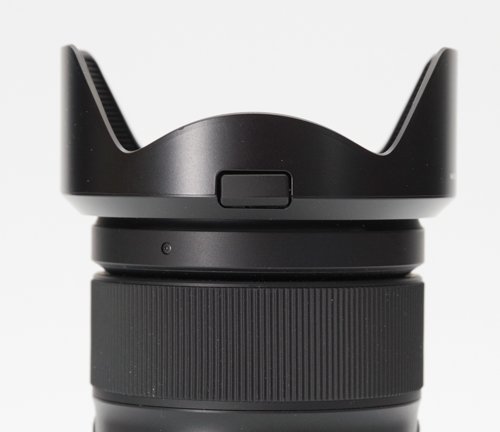
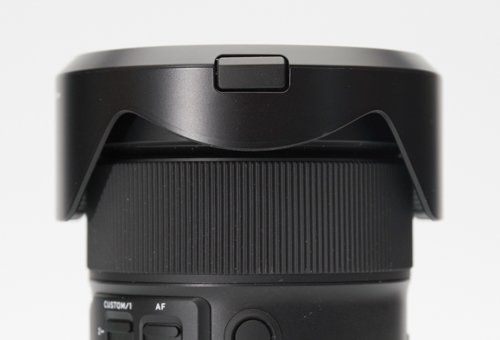
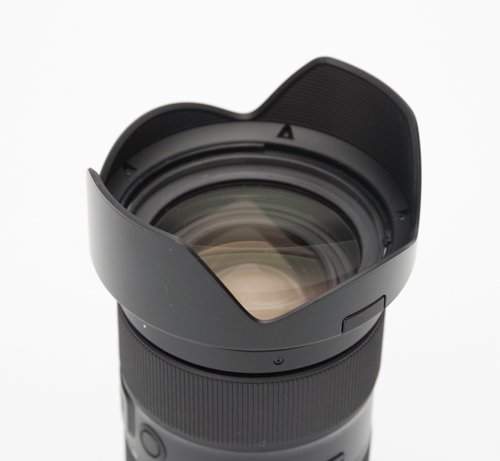
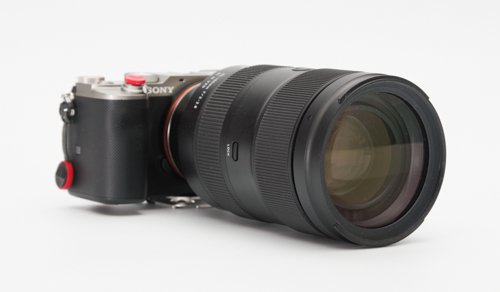
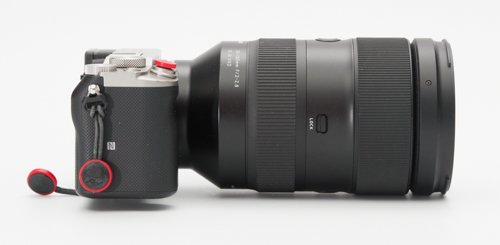









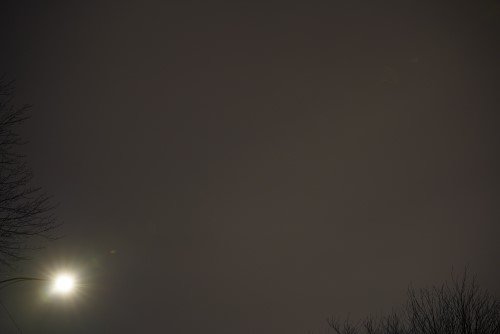
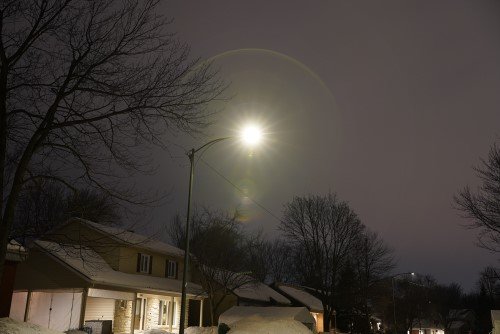

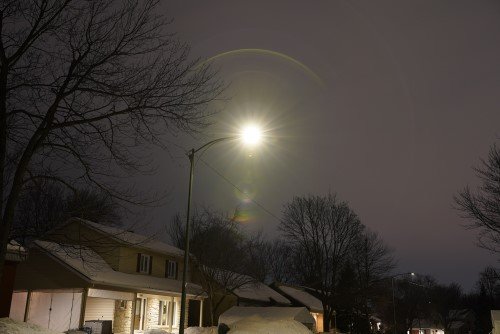


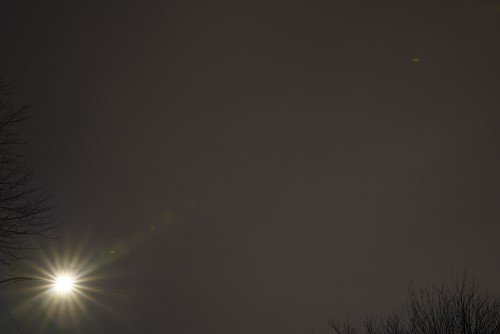
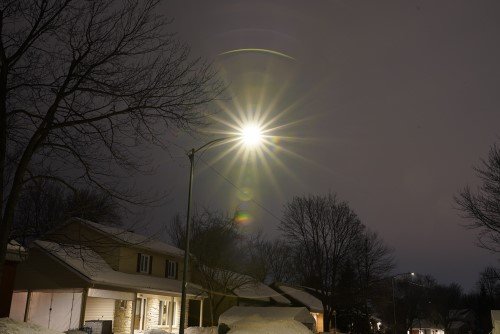
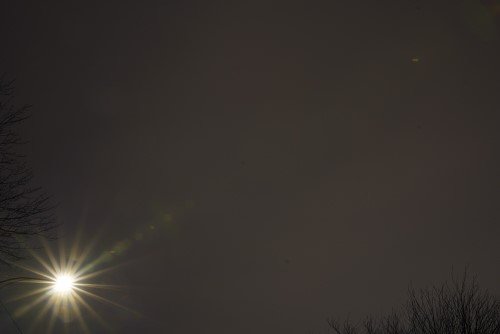
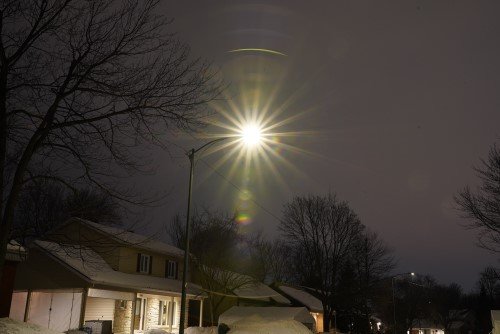

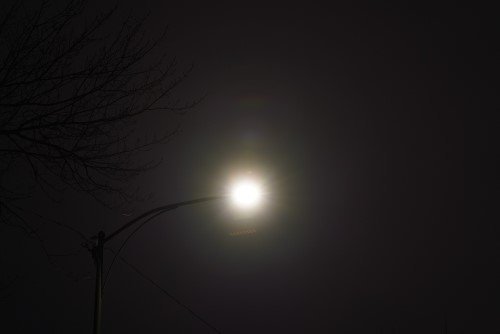
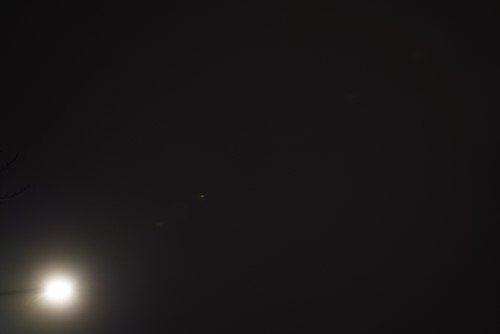


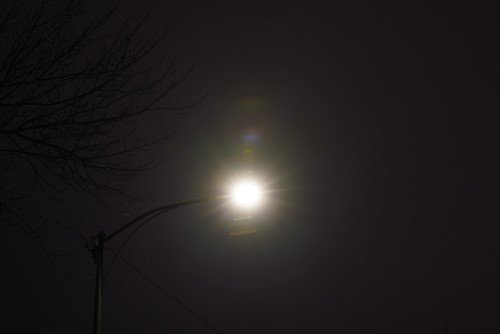

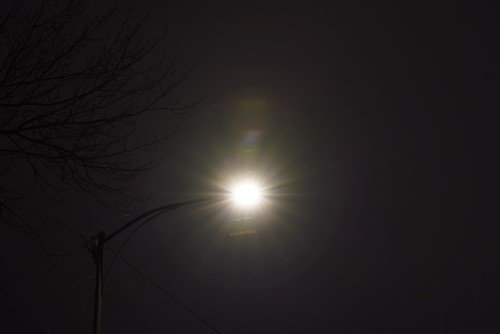

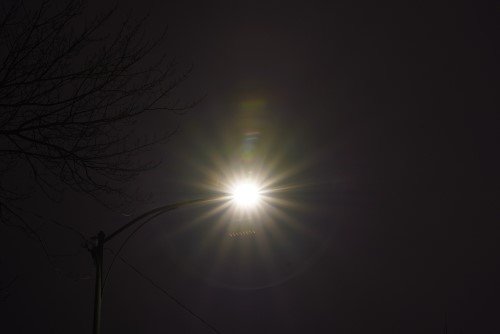

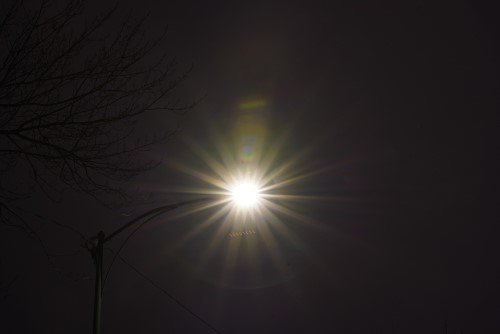

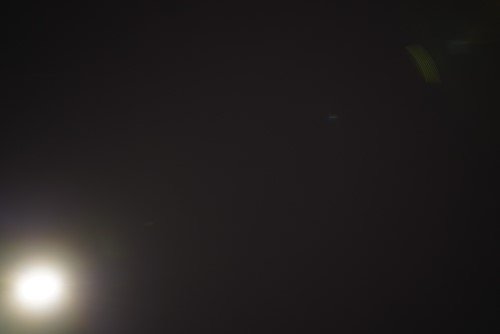
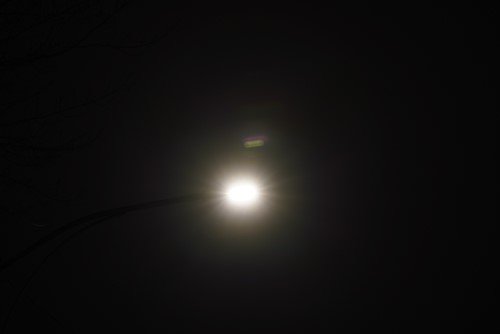






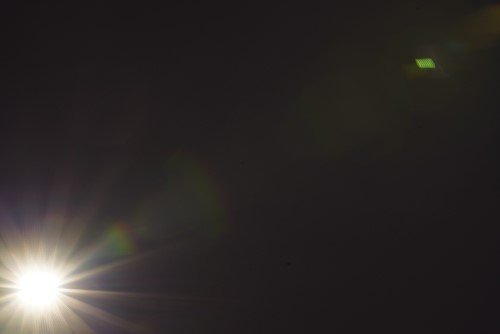

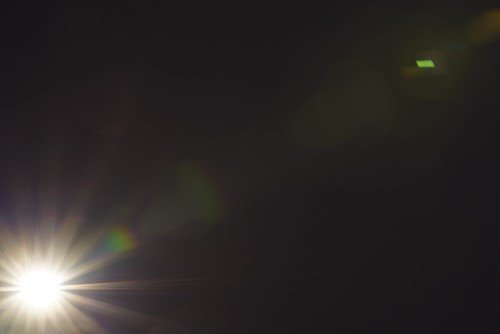







I’ve had this tamron for almost 1 year it’s really fabulous it stays on my A7C almost all the time except when I want to be discreet I put the kit lens on which does a really good job also in bright weather or when I need a little more angle the small tamron 24mm 2.8 and well for really cheap. on the other hand I can’t at all put a function of the body on a custom lens I wanted to put the crop apsc function how to do it?
I finally managed to customize the button 🙂
Leave it to the US to screw shit up lol. ont get me wrong. i love my country but they have been screwing things up for awhile now. Anyway, amazon here says they dont know when or if they will get this lens but i oredered it from B&H and they cant tell me when this things will ship. But i ordered it 3 weeks ago.
Hi, I’m struggling with AF on the Tamron 35-150 with sony a7r3 and a7iii. Coming from 24-70 Gm and 70-200, this lens only gets a hit rate of 30-40% and is pretty bad in low light and at 150mm it rarely hits focus 1-2 of 10 images are in focus… I’ve read you had some issues with AF as well. What is your success rate for AF?
Hi Samuel!
The hit rate was pretty high, it is just uncommon for the camera to lose the subject even once so I mentioned it. The 35-150mm is not “the best” I have used but still excellent.
A hit rate such as you mention is not normal. Of course, in low light at 150mm it could very well be motion blur and not focus problems. Since you own the 70-200mm, I would assume you don’T see a similar behaviour in similar circumstances? That would be the first thing to check. Maybe a side-by-side controlled test using a tripod. If the Tamron does struggle more, it might be a defective copy. Or it might need to be updated via its USB port.
Just got the lens last week. Liking it so far on my A7RIVA. Will update as it gets more use!
How did you get this lens?? i just put my order in and they cant even tell me when or if ill even get it? lol
I assume it varies depending on the retailer and country. Here in Canada, Amazon ships it in 2-3 days.